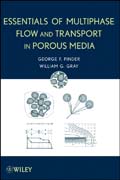
This book looks at the mathematical-physical rationale behind the equations that are currently used to describe the flow of fluid and transport of solutes in porous media. It presents a comprehensive approach to the development of appropriate equations without prior knowledge of continuum mechanics, mixture theory, or similar areas of expertise. The book carries the reader from the simplest of concepts to the final equations and then illustrates how the equationscan be used to solve practical problems. This book will fill the need for a reference and text in the physics of flow in porous media at the advanced undergraduate-graduate level and can also be used as a professional reference. INDICE: 1. Setting the Stage. 1.1 Introduction. 1.2 Phases and Porousmedia. 1.3 Grain and Pore Size Distributions. 1.4 The Concept of Saturation. 1.5 The Concept of Pressure. 1.6 Surface Tension Considerations. 1.7 Concept of Concentration. 1.8 Summary. 1.9 Exercises. 2. Mass Conservation Equations. 2.1 Introduction. 2.2 Microscalemass Conservation. 2.3 Integral Forms Ofmass Conservation. 2.4 Integral Theorems. 2.4.1 Divergence Theorem. 2.4.2 Transport Theorem. 2.5 Point Forms Ofmass Conservation. 2.6 Themacroscale Perspective. 2.6.1 The Representative Elementary Volume. 2.6.2 Global and Local Coordinate Systems.2.6.3 Macroscopic Variables. 2.6.4 Definitions Of Macroscale Quantities. 2.6.5 Summary Of Macroscale Quantities. 2.7 The Averaging Theorems. 2.7.1 Spatial Averaging Theorem. 2.7.2 Temporal Averaging Theorem. 2.8 Macroscalemass Conservation. 2.8.1 Macroscale Point Forms. 2.8.2 Integral Forms. 2.9 Applications. 2.9.1 Integral Analysis. 2.9.2 Point Analysis. 2.10 Summary. 2.11 Exercises. 3. Flow Equations. 3.1 Introduction. 3.2 DarcyS Experiments. 3.3 Fluid Properties. 3.4 Equations of State for Fluids. 3.4.1 Mass Fraction. 3.4.2 Mass Densityand Pressure. 3.4.3 Fluid Viscosity. 3.5 Hydraulic Potential. 3.5.1 Hydrostatic Force and Hydraulic Head. 3.5.2 Derivatives of Hydraulic Head. 3.6 Single Phase Fluid Flow. 3.6.1 DarcyS Law. 3.6.2 Hydraulic Conductivity and Permeability. 3.6.3 Derivation of Groundwater Flow Equation. 3.6.4 Recapitulation of theDerivation. 3.6.5 Initial and Boundary Conditions. 3.6.6 Two-Dimensional Flow. 3.7 Two-Phase Immiscible Flow. 3.7.1 Derivation of Flowequations. 3.7.2 Observations on the Pc - Sw Relationship. 3.7.3 Formulas for The Pc - Sw Relationship. 3.7.4 Observations of the Kà Rel - Sw Relationship. 3.7.5 Formulas for the Kà Rel - Sw Relation. 3.7.6 Special Cases of Multiphase Flow. 3.8 The Buckley-Leverett Analysis. 3.8.1 Fractional Flow. 3.8.2 Derivation of the Buckley-Leverett Equation. 3.8.3 Solution of the Buckley-Leverett Equation. 3.9 Summary.3.10 Exercises. 4. Mass Transport Equations. 4.1 Introduction. 4.2 Velocity in the Species Transport Equations. 4.2.1 Direct Approach. 4.2.2 Rigorous Approach. 4.2.3 Distribution Approach. 4.2.4 Summary. 4.3 Closure Relations for theDispersion Vector. 4.4 Chemical Reaction Rates. 4.5 Interphase Transfer Terms. 4.5.1 Kinetic Formulation. 4.5.2 Equilibriumformulation. 4.5.3 Summary: Kinetic Vs. Equilibrium Formulations. 4.6 Initial and Boundary Conditions. 4.7 Conclusion. 4.8 Exercises. 5. Simulation. 5.1 1-D Simulation of Air-Water Flow. 5.1.1 Drainage in a Homogeneous Soil. 5.1.2 Drainage in a Heterogeneous Soil. 5.1.3 Imbibition in Homogeneous Soil. 5.2 1-D Simulation of Dnapl-Water Flow. 5.2.1 Primary Dnapl Imbibition In Homogeneous Soil. 5.2.2 Density Effect. 5.2.3Dnapl Drainage in Homogeneous Soil. 5.2.4 Secondary Imbibition of Dnapl in Homogeneous Soil. 5.2.5 Secondary Drainage in Homogeneous Soil. 5.2.6 Primary Imbibition in Heterogeneous Soil. 5.3 2-D Simulation of Dnapl-Water Flow. 5.3.1 Dnapl Descent into a Water-Saturated Reservoir. 5.4 Simulation Of Multiphase Flow And Transport. 5.4.1 1-D Two-Phase Flow and Transport. 5.4.2 2-D Two-PhaseFlow and Transport. 5.5 2-D Single-Phase Flow and Transport. 5.5.1 Base-Case.5.5.2 Effect of Inflow. 5.5.3 Impactofwell Discharge. 5.5.4 Effect of Adsorption. 5.5.5 Effect of a Low Transmissivity Region. 5.5.6 Effect of a High Transmissivity Region. 5.5.7 Effect of Rate of Reaction. 5.6 3-D Single-Phase Flow and Transport. 5.7 2-D Three-Phase Flow. 5.8 Summary. 6. Select Symbols.
- ISBN: 978-0-470-31762-4
- Editorial: John Wiley & Sons
- Encuadernacion: Cartoné
- Páginas: 272
- Fecha Publicación: 01/08/2008
- Nº Volúmenes: 1
- Idioma: Inglés
